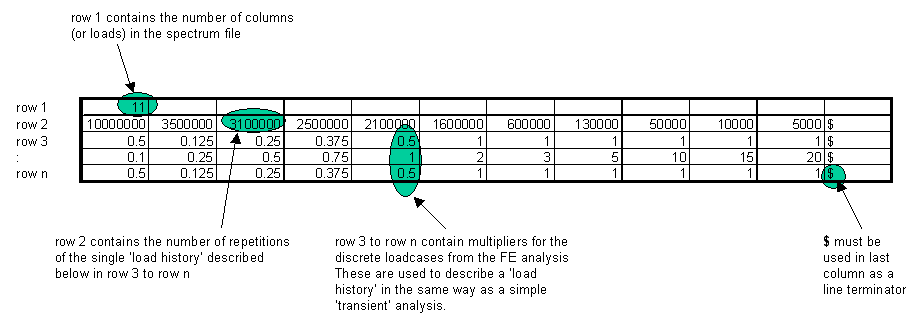With Fatigue Wizard, you can perform a fatigue damage calculation using a ‘load spectrum' or ‘duty cycle’. This type of analysis is a computationally efficient method to assess a structure or component in terms of its durability over various loading conditions.
You control the spectrum analysis with a comma separated (.csv) text file containing the description of the applied loads and repetitions of each load. To edit these files, use a text editor, such as Notepad, and import into the Fatigue Wizard in Step 4.
Below is an example of the spectrum file format, and a description of each of the required values

Using the example above, the damage summation is performed as follows:
- Row 1 contains the total number of discrete loads that make up the spectrum file. In this case there are 11 discrete loads, so there are 11 columns in the spectrum file.
- Fatigue Wizard then reads each column of data from the spectrum file and creates individual ‘load histories from each column.
- Rows 3 to row 5 contain multipliers for load cases 1 to 3 of the FEA . These multipliers are applied in addition to any multipliers input directly on step 4 of the Fatigue Wizard. The description of this single load history is identical to a transient analysis based on load cases from the FEA.
- The load history defined by row 3 to row n is then repeated a defined number of times. The number of repetitions is defined by the number in row 2.
- A damage is calculated for the cycle and number of repetitions described above.
- Fatigue Wizard then repeats the previous steps for each column in the spectrum file.
- A total damage is summed over all of the load histories and reported.
The example spectrum file in the comma separated format is as follows:
11 10000000,3500000,3100000,2500000,2100000,1600000,600000,130000,50000,10000,5000,$ 0.5,0.125,0.25,0.375,0.5,1,1,1,1,1,1,$ 0.1,0.25,0.5,0.75,1,2,3,5,10,15,20,$ 0.5,0.125,0.25,0.375,0.5,1,1,1,1,1,1,$